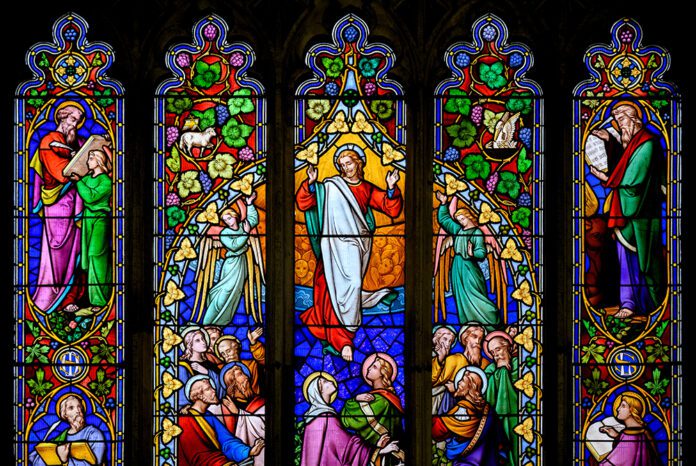As we near the end of the liturgical year, our first reading and gospel this weekend remind us that, at an unknown day and hour, all of time will end, and Jesus will come again. Over the last several weeks, however, our second reading has been taken from the Letter to the Hebrews. This is the last weekend we’ll read from it, so it’s worth commenting on it before it’s too late.
The Catholic Church teaches, in the language of the Catechism, that “The Mass is at the same time, and inseparably, the sacrificial memorial in which the sacrifice of the cross is perpetuated and the sacred banquet of communion with the Lord’s body and blood” (CCC 1382). “Sacrifice” and “sacred banquet:” these are the two terms which the Church uses to refer to the Mass. Very rarely, if ever, does the Church use the word “meal,” to refer to the Mass. If you were to read what is called the General Instruction of the Roman Missal, which outlines the Church’s theology and practice of the Mass, you would find that the word “sacrifice” occurs 38 times in reference to the Mass, the word “banquet” 8 times, and the word “meal,” 0 times. Similarly, if you were to read the Church’s Constitution on the Sacred Liturgy from the Second Vatican Council, “sacrifice” occurs 9 times, “banquet” 1 time, and “meal” 0 times. “Meal” just isn’t a word which the Church typically uses to refer to the Mass. “Sacrifice” is clearly the predominant term; and “banquet,” which is not merely a synonym for “meal,” is the secondary term.
Now this might surprise us, because many of us may have been taught, as I was taught, that the Mass is primarily, if not exclusively, a meal. When I was growing up, “meal” was the favored term used to refer to the Mass. It was the term I heard in homilies, in hymns, and in religion classes. Rarely, if ever, did I hear the Mass spoken of as a “sacrifice. “Banquet” may have been used from time to time, but never “sacrifice.” This term was just not on the lips of priests, musicians, or catechists. And this was problematic—not only because it misrepresented the Church’s theology of the Mass, but it tended to lead, whether intentionally or not, to disbelief in the Real Presence of Jesus Christ in the Eucharist.
It’s possible, at least conceptually, to separate the idea of the Mass as a “meal” from the truth that the food and drink we consume at Mass really is Jesus’ Body, Blood, Soul and Divinity. All that a meal requires is food, drink, and people to share it. And so even if the Eucharist isn’t the Real Presence of Jesus—which, of course, it is—but even if it isn’t, the Mass can still be a meal: there’s food, drink, and people to share it. The Mass being a meal doesn’t require the Eucharist to be Jesus’ Body, Blood, Soul and Divinity. But the Mass being a sacrifice—and not just any sacrifice, but the same sacrifice that was offered by Jesus on the Cross—does require the Real Presence of Jesus Christ in the Eucharist.
The Church teaches that at every the Mass, the same sacrifice which Jesus Christ offered on the Cross two thousand years ago, is made present on the altar. This teaching follows from what we heard in our second reading. Our second reading began by pointing out that in the Old Testament, the priests had to offer many different sacrifices. And they had to do this, because none of these sacrifices were perfect; none of them, by themselves, could take away every sin: every past sin, every present sin, and every future sin. But Jesus’ sacrifice on the Cross, because it was perfect, could take away every sin: past, present, and future. As, such, no more sacrifices had to be offered. One sacrifice was offered, once and for all.
The Church teaches that this one sacrifice, which was offered once and for all, is made present on the altar at every Mass. Jesus isn’t sacrificed again at every Mass, as if His first sacrifice wasn’t enough; rather, that first sacrifice, that one sacrifice, that happened two-thousand years ago, is made present again. And it’s made present for our benefit. We weren’t there when Jesus was crucified. But we are brought to the foot of the Cross, we have the opportunity to kneel at the foot of Mount Calvary, at every Mass. It’s like when Jesus was crucified, a bomb of infinite love and mercy exploded. And the Mass makes it possible for us to still feel the shockwaves of that bomb no matter how distant we are in time from ground zero.
But in order for the same sacrifice to be made present at every Mass, Jesus had to ensure that at every Mass the sacrifice would be the same: that is, that there would be the same priest, the same victim, the same altar, and the same reason for the sacrifice. Now on the Cross, Jesus was simultaneously the priest, the victim, and the altar. He was the priest, because He was the one who offered the sacrifice. He was the victim, because He was the sacrifice that was offered. And He was the altar, because He Himself was the place where the sacrifice was offered. This last one is a bit harder for us to grasp. In fact, we sometimes think of the Cross as the altar where Jesus offered Himself. But in reality, the Cross became an altar—a place of sacrifice—only because Jesus first offered Himself to the Father on the altar of His heart. It is because Jesus Himself was the altar that the Cross was an altar as well. So on the Cross, Jesus was the priest, the victim, and the altar. And the reason for His sacrifice was the glory of His Heavenly Father and the forgiveness of our sins.
In order for the same sacrifice to be offered at every Mass, all of these things have to be the same, and they are. In the first place, there is the same priest, because even though the human personality of each priest is different, when a priest says the words of consecration at Mass, it is Christ Himself who says these words. At this moment, the same priest, Christ, borrows, as it were, the lips of the priest who has been ordained to act in His very Person. Secondly, there is the same victim, because after the words of consecration, Jesus Christ—Body, Blood, Soul and Divinity—becomes present on the altar, the same victim that was offered on the Cross. Given that, it’s clear why the idea of the Mass as a sacrifice is inseparable from the truth of the Real Presence of Jesus Christ in the Eucharist. Unlike the idea of the Mass as a meal, the idea of the Mass as a sacrifice and the truth of the Real Presence cannot be separated. Lastly, there is the same altar, because Jesus Himself is the altar. Once the same victim is made present at Mass, the same altar is made present as well.
This same sacrifice is also offered for the same reason. The sacrifice of the Mass, like the sacrifice of Jesus on the Cross, is offered for the Glory of God the Father and the forgiveness of our sins. That is what we mean when we say to the priest at Mass, “May the Lord accept the sacrifice at your hands for the praise and glory of his name”—that, is the Father’s name—and, “for our good and the good of all his holy Church”—that is, for the forgiveness of our sins. We’re saying that the sacrifice of the Mass if offered for the same reason as the sacrifice of Jesus on the Cross: the Glory of God the Father and the forgiveness of our sins.
The only difference between the sacrifice of Jesus on the Cross and the sacrifice of the Mass, is the manner in which the sacrifice is offered. On the Cross, Jesus offered Himself in a bloody manner. When He was scourged at the pillar, and when his hands, feet, and head were pierced with nails and thorns, His Blood was separated from His Body. He physically bled. At Mass, except in the rare case of a Eucharistic Miracle where the Host will physically bleed, the same sacrifice is offered in an unbloody manner. Jesus doesn’t physically bleed at Mass. His Blood is not physically separated from His Body. But on a spiritual level, that is actually the reason for what’s called the “double consecration” at Mass.
Think about how the bread and wine are consecrated at Mass. First, the bread is consecrated. After it is consecrated, it becomes Jesus Body. And because Jesus’ Body is resurrected, and can no longer be separated from any other aspect of Him, when His Body becomes present, His Blood, Soul and Divinity become present as well. Then the wine is consecrated. After it is consecrated, it becomes Jesus Blood. And because Jesus’ Blood is resurrected, and can no longer be separated from any other aspect of Him, when His Blood becomes present, His Body, Soul and Divinity become present as well. But although Jesus’ Body and Blood can no longer be separated physically, the bread and wine are consecrated separately at Mass in order to sacramentalize the physical separation of Jesus’ Body and Blood on the Cross. Jesus’ sacrifice on the cross was bloody; this same sacrifice is made present on the altar in an unbloody manner.
What does this mean for us? Why explain all of it in a homily? Well, in the first place, because it’s the truth. And because it’s been my experience, in the short time I’ve been a priest, that many Catholics don’t realize that it’s the truth. Many Catholics, like myself, were taught that the Mass was primarily, if not exclusively, a meal. Now, the Mass is a banquet: it’s a sacred banquet, a paschal banquet, a Eucharistic banquet: but it’s not merely a meal. And, most especially, the Mass is a sacrifice: the same sacrifice which Jesus offered on the Cross. And if we forget that, we will likely forget What, or rather Who, we are receiving in Holy Communion: Jesus’ Real Presence, Body, Blood, Soul and Divinity. Count how many times the word “sacrifice,” “victim,” “offering,” or “oblation” occurs in the Eucharistic Prayer. That should make it abundantly clear that this isn’t just a meal we’re celebrating at the altar.
On the Cross two thousand years ago, a bomb of an unfathomable love and inexhaustible mercy exploded for the glory of God the Father and the forgiveness of our sins. At this Mass, we have the opportunity to experience the effects of that bomb, to feel a shock-wave of infinite love and mercy emanating from this altar. Let us open our hearts to receive this great grace, and to give thanks for the sacrifice of Jesus—offered once and for all—but made present for us at every Mass.






